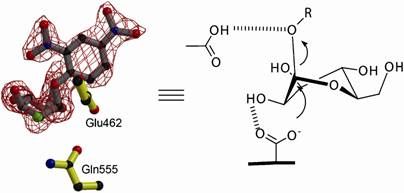Volcanoes and Nanotechnology
Etna produces catalyst: direct synthesis of carbon nanotubes with volcanic rock
Advertisement
Since their discovery in the early 1990s, carbon nanotubes and carbon nanofibers - tiny structures made of pure carbon - have been used in a wide variety of applications. They have become indispensable in the nanosciences and nanotechnology. However, because their production on an industrial scale remains expensive, their commercial use in such areas as catalysis has remained unthinkable. This could now be changing, thanks to researchers from the Fritz Haber Institute in Berlin: Dang Sheng Su and his co-workers have used igneous rock from Mount Etna to produce carbon nanotubes and fibers directly by deposition from the gas phase. As they explain in the journal Angewandte Chemie, the naturally occurring iron oxide particles in lava make it an effective natural catalyst, possibly smoothing the way to a more efficient production method.
Lava rock is extremely porous and contains large quantities of finely divided iron oxides. This is just what is needed for the synthesis of these tiny carbon structures. The researchers pulverize the rocks and heat them to 700 °C under a hydrogen atmosphere. This reduces the iron oxide particles to elemental iron. When a mixture of the gases hydrogen and ethylene is directed over the powder, the iron particles catalyze the decomposition of ethylene to elemental carbon. This is deposited on the lava rock in the form of tiny tubes and fibers. The catalyst is produced naturally in large quantities and is thus affordable; the catalytic iron does not need to be deposited on any kind of substrate, as the lava is both catalyst and substrate in one; and this process works without any "wet" chemical steps.
The geological aspect of this reaction is also quite interesting: if a carbon source is present, carbon nanotubes and fibers can be formed on minerals at relatively moderate temperatures. Volcanoes produce gases such as methane and hydrogen. Could these forms of carbon already have been generated on Earth millions of years ago? Hydrogen, carbon oxides, and metallic iron are also present in interstellar space - could these little tubes and fibers be produced in space?
Originalveröffentlichung: Dang Sheng Su et al.; "Natural Lavas as Catalysts for Efficient Production of Carbon Nanotubes and Nanofibers"; Angewandte Chemie International Edition 2007.
Other news from the department science
Most read news
More news from our other portals
See the theme worlds for related content
Topic world Synthesis
Chemical synthesis is at the heart of modern chemistry and enables the targeted production of molecules with specific properties. By combining starting materials in defined reaction conditions, chemists can create a wide range of compounds, from simple molecules to complex active ingredients.

Topic world Synthesis
Chemical synthesis is at the heart of modern chemistry and enables the targeted production of molecules with specific properties. By combining starting materials in defined reaction conditions, chemists can create a wide range of compounds, from simple molecules to complex active ingredients.

































































